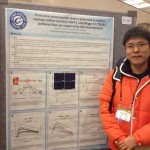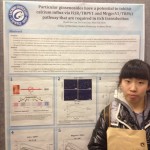2012-11-26 고려인삼학회포스터
A particular ginsenoside has a potential to inhibit itch transduction
Wook-Joo Lee, Dasom Choi, Won-Sik Shim*
College of Pharmacy, Gachon University, Incheon, 406-799, South Korea
Purpose:
Korean red ginseng (the steamed root of Panax ginseng C.A. Meyer, family Araliaceae) has been used as a remedy for wide variety of disorders, and recent studies have identified its beneficial use in itch-related diseases such as atopic dermatitis. Although its anti-pruritic effect was mostly revealed by animal scratching tests, its underlying molecular mechanism has never been investigated. Because the itch transduction in peripheral nervous system could be initiated via histamine-dependent (H1R/TRPV1), or -independent (MrgprA3/TRPA1) pathway, the putative inhibitory effect of various ginsenosides were investigated in the present study.
Method:
cDNA combinations of H1R/TRPV1 or MrgprA3/TRPA1 were transiently expressed in human embryonic kidney (HEK) 293T cells, and calcium influx was monitored with Fluo3-AM, a calcium-specific fluorescent dye. To test the inhibitory effect, 11 ginsenosides were pretreated for 10 min, and either histamine (for H1R/TRPV1) or chloroquine (for MrgprA3/TRPA1) was treated and changes were recorded for 1 min.
Result:
It was found that one particular ginsenoside strongly inhibited the calcium influx on both H1R/TRPV1- and MrgprA3/TRPA1-expressing cells even after histamine or chloroquine was treated, suggesting that the ginsenoside may have a potential anti-pruritic activity. Furthermore, it seems that the inhibitory effect is mediated by directly blocking the action of ion channels (TRPV1, TRPA1) rather than interfering with receptors (H1R, MrgprA3), implying other possible roles especially in nociception.
2012-11-26 고려인삼학회포스터 Read More »


